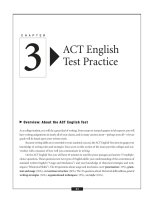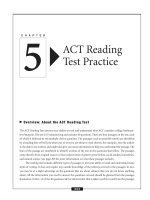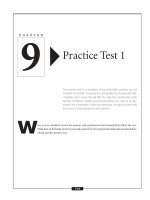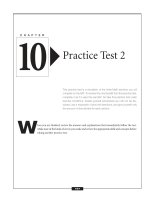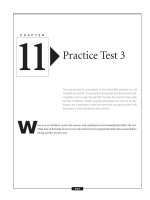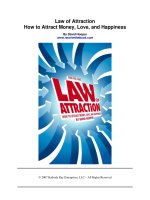– ACT MATH TEST PRACTICE – 1. How is five hundred twelve and sixteen thousandths written in pptx
Bạn đang xem bản rút gọn của tài liệu. Xem và tải ngay bản đầy đủ của tài liệu tại đây (597.44 KB, 34 trang )
1. How is five hundred twelve and sixteen thousandths written in decimal form?
a. 512.016
b. 512.16
c. 512,160
d. 51.216
e. 512.0016
2. 4
ᎏ
1
3
ᎏ
− 1
ᎏ
3
4
ᎏ
= ?
f. 2
ᎏ
1
7
2
ᎏ
g. 3
ᎏ
1
5
2
ᎏ
h. 3
ᎏ
2
3
ᎏ
i. 2
ᎏ
1
5
2
ᎏ
j. 1
ᎏ
1
8
ᎏ
3. Simplify |3 − 11| + 4 × 2
3
.
a. 24
b. 40
c. 96
d. 520
e. 32
4. The ratio of boys to girls in a kindergarten class is 4 to 5. If there are 18 students in the class, how
many are boys?
f. 9
g. 8
h. 10
i. 7
j. 12
5. What is the median of 0.024, 0.008, 0.1, 0.024, 0.095, and 0.3?
a. 0.119
b. 0.095
c. 0.0595
d. 0.024
e. 0.092
– ACT MATH TEST PRACTICE–
165
6. Which of the following is NOT the graph of a function?
f.
g.
h.
i.
j.
– ACT MATH TEST PRACTICE–
166
7. 4.6 × 10
5
= ?
a. 4.60000
b. 0.000046
c. 4,600,000
d. 460,000
e. 0.0000046
8. What is the value of x
5
for x = 3?
f. 15
g. 243
h. 125
i.
ᎏ
5
3
ᎏ
j. 1.6
9. What is the next number in the pattern below?
0,3,8,15,24,
a. 35
b. 33
c. 36
d. 41
e. 37
10. What is the prime factorization of 84?
f. 42 × 2
g. 7 × 2 × 3
h. 2
2
× 3 × 7
i. 2 × 6 × 7
j. 2
3
× 7
11. Find the slope of the line 7x = 3y − 9.
a. 3
b. −9
c.
ᎏ
7
3
ᎏ
d. −3
e.
ᎏ
3
7
ᎏ
– ACT MATH TEST PRACTICE–
167
12. The perimeter of a rectangle is 20 cm. If the width is 4 cm, find the length of the rectangle.
f. 6 cm
g. 16 cm
h. 5 cm
i. 12 cm
j. 24 cm
13. Find the area of the figure below.
a. 79 square inches
b. 91 square inches
c. 70 square inches
d. 64 square inches
e. 58 square inches
14. Five cans of tomatoes cost $6.50. At this rate, how much will 9 cans of tomatoes cost?
f. $13.00
g. $11.70
h. $1.30
i. $11.90
j. $12.40
15. For all x ≠ 0,
ᎏ
3
2
x
ᎏ
+
ᎏ
1
5
ᎏ
= ?
a.
ᎏ
1
2
5x
ᎏ
b.
ᎏ
1
1
0
5
+
+
3
x
x
ᎏ
c.
ᎏ
10
1
+
5x
3x
ᎏ
d.
ᎏ
15
2
+ x
ᎏ
e.
ᎏ
5
1
x
ᎏ
10 in
7 in
7 in
3 in
– ACT MATH TEST PRACTICE–
168
16. Which inequality best represents the graph below?
f. −1.5 > x > −1
g. x ≤ 0
h. −0.5 > x > 0
i. −1.5 < x < 0
j. −1.5 ≤ x ≤ 0
17. Simplify −(6x
4
y
3
)
2
.
a. −36x
6
y
5
b. 36x
2
y
c. −36x
8
y
6
d. 36x
8
y
4
e. −36xy
18. If 2x + 3y = 55 and 4x = y + 47, find x − y.
f. 28
g. 16
h. 5
i. 12
j. 24
19. Which inequality represents the graph below?
a. −4x < 0
b. −20x > 5
c. x < −4
d. −x ≤−4
e. −x < 4
20. Simplify ͙
3
16x
5
y
4
ෆ
.
f. 2xy͙
3
2x
2
y
ෆ
g. 8x
2
y
h. 8xy͙
3
2
ෆ
i. 2xy͙
3
xy
ෆ
j. 4x
2
y
2
͙
3
x
ෆ
−40 4
−2−3 −10 1
– ACT MATH TEST PRACTICE–
169
21. The formula to convert Celsius to Fahrenheit is F =
ᎏ
5
9
ᎏ
C + 32, where F is degrees Fahrenheit, and C is
degrees Celsius. What Fahrenheit temperature is equivalent to 63° Celsius?
a. 32°
b. 95°
c. 67°
d. 83°
e. 47°
22. What are the solutions to the equation x
2
+ 8x + 15 = 0?
f. {8, 15}
g. {0}
h. {−5, −3}
i. no solution
j. {2, 4}
23. If 5k = 9m − 18, then m = ?
a. 5k + 18
b.
ᎏ
5
9
ᎏ
k + 2
c. −9 + 5k
d. 5k + 9
e. 9k + 18
24. What is the solution set for 5x − 7 = 5(x + 2)?
f. {2}
g. {7}
h. no solution
i. all real numbers
j. all positive numbers
25. Simplify
ᎏ
4x
2
+
x +
11
3
x − 3
ᎏ
for all x ≠−3.
a. 3x
2
+ 11
b. 2x + 1
c. 4x
2
+ 12x
d. 4x
2
+ 10x − 6
e. 4x − 1
– ACT MATH TEST PRACTICE–
170
26. If x =
[]
and y =
[]
, find x − y.
f.
[]
g.
[]
h.
[]
i.
[]
j.
[]
27. If log
3
x = 2, then x = ?
a. 6
b. 9
c.
ᎏ
2
3
ᎏ
d. 4
e.
ᎏ
1
2
ᎏ
28. Simplify
ᎏ
x
x
2
−
−
3
9
ᎏ
.
f. x − 12
g. x − 6
h. x + 3
i. −x
2
− 6
j. x − 3
29. The vertices of a triangle are A(−1, 3), B(3, 0), and C(−2, −1). Find the length of side A
ෆ
C
ෆ
.
a. ͙15
ෆ
b. ͙17
ෆ
c. 19
d. 17
e. 3͙6
ෆ
61
25
41
28
−50
−6 −6
18
46
50
66
−24
−10
34
56
– ACT MATH TEST PRACTICE–
171
30. Which of the following equations has a graph that has a y-intercept of 4 and is parallel to 3y − 9x = 24?
f. −12x + 4y = 16
g. 9x − 3y = −15
h. 2y = 4x + 8
i. 7y = 14x + 7
j. 3x − 9y = 14
31. At what point do the lines x = 9 and 3x + y = 4 intersect?
a. (3, 9)
b. (
ᎏ
5
3
ᎏ
,9)
c. (−20, −9)
d. (9, −23)
e. (9, 4)
32. Which of the numbers below is the best approximation of (͙37
ෆ
)(͙125
ෆ
)?
f. 52
g. 4,600
h. 150
i. 66
j. 138
33. What is the solution set of the equation x
2
− 4x − 4 = 2x + 23?
a. {−4, 4}
b. {−4, 23}
c. {1, 11.5}
d. {−3, 9}
e. {5, 6}
34. If a fair coin is flipped and a die is rolled, what is the probability of getting tails and a 3?
f.
ᎏ
1
2
ᎏ
g.
ᎏ
1
1
2
ᎏ
h.
ᎏ
1
6
ᎏ
i.
ᎏ
1
4
ᎏ
j.
ᎏ
1
8
ᎏ
– ACT MATH TEST PRACTICE–
172
35. What is
ᎏ
1
2
ᎏ
% of 90?
a. 45
b. 0.045
c. 4.5
d. 0.45
e. 450
36. Between which two integers does ͙41
ෆ
lie?
f. 5 and 6
g. 8 and 9
h. 4 and 5
i. 7 and 8
j. 6 and 7
37. Mike has 12 bags of shredded cheese to use to make pizzas. If he uses
ᎏ
3
4
ᎏ
of a bag of cheese for each
pizza, how many pizzas can he make?
a. 12
b. 24
c. 36
d. 9
e. 16
38. Greene ran the 100-meter dash in 9.79 seconds. What was his speed in kilometers per hour (round to
the nearest kilometer)?
f. 31 km/h
g. 37 km/h
h. 1 km/h
i. 10 km/h
j. 25 km/h
39. Larry has 4 blue socks, 6 red socks, and 10 purple socks in his drawer. Without looking, Larry ran-
domly pulled out a red sock from the drawer. If Larry does not put the red sock back in the drawer,
what is the probability that the next sock he randomly draws will be red?
a.
ᎏ
1
4
ᎏ
b.
ᎏ
1
3
0
ᎏ
c.
ᎏ
1
5
9
ᎏ
d.
ᎏ
3
7
ᎏ
e.
ᎏ
1
6
ᎏ
– ACT MATH TEST PRACTICE–
173
40. What is the product of 5 × 10
−4
and 6 × 10
8
?
f. 11 × 10
4
g. 3 × 10
4
h. 1.1 × 10
5
i. 3 × 10
5
j. 5.6 × 10
−4
41. What is the sine of angle B in the triangle below?
a.
ᎏ
3
4
ᎏ
b.
ᎏ
3
5
ᎏ
c.
ᎏ
4
3
ᎏ
d.
ᎏ
4
5
ᎏ
e.
ᎏ
5
4
ᎏ
42. Find tan x for the right triangle below.
f.
ᎏ
5
4
ᎏ
g.
ᎏ
3
4
ᎏ
h.
ᎏ
4
3
ᎏ
i.
ᎏ
6
3
ᎏ
j.
ᎏ
5
3
ᎏ
4
5
3
x°
A
B
8
6
C
– ACT MATH TEST PRACTICE–
174
43. The surface area of a box is found by taking the sum of the areas of each of the faces of the box. Find
the surface area of a box with dimensions 6 inches by 8 inches by 10 inches.
a. 480 sq in
b. 138 sq in
c. 346 sq in
d. 376 sq in
e. 938 sq in
44. Find the area of the shaded region. Recall that the area of a circle is πr
2
,where r is the radius of the
circle.
f. 65π
g. 6π
h. 25π
i. 5π
j. 33π
45. The area of square WXYZ is 100 square centimeters. Find the length of diagonal WY in centimeters.
a. 10͙2
ෆ
cm
b. 20 cm
c. 10 cm
d. 2͙5
ෆ
cm
e. 10͙5
ෆ
cm
46. Find the hypotenuse of the triangle below.
f. ͙13
ෆ
g. ͙5
ෆ
h. ͙65
ෆ
i. ͙97
ෆ
j. 13
4
9
3
4
3
– ACT MATH TEST PRACTICE–
175
47. A circular lid to a jar has a radius of 3
ᎏ
1
2
ᎏ
inches. Find the area of the lid.
a.
ᎏ
1
4
2
9
ᎏ
π sq in
b.
ᎏ
4
1
9
2
ᎏ
π sq in
c.
ᎏ
4
4
9
ᎏ
π sq in
d.
ᎏ
7
2
ᎏ
π sq in
e.
ᎏ
4
4
9
ᎏ
π sq in
48. What is the value of x when y is equal to 15 for the equation y = 4x
2
− 1?
f. 2
g. 16
h. 64
i. ͙5
ෆ
j. 0
49. The senior class at Roosevelt High has 540 students. Kristen won the election for class president with
60% of the vote. Of that 60%, 75% were female. Assuming that the entire senior class voted, how many
females voted for Kristen?
a. 195
b. 405
c. 324
d. 227
e. 243
50. If cosθ =
ᎏ
1
6
7
ᎏ
and tanθ =
ᎏ
5
6
ᎏ
, then sinθ = ?
f.
ᎏ
1
5
7
ᎏ
g.
ᎏ
6
5
ᎏ
h.
ᎏ
1
5
7
ᎏ
i.
ᎏ
5
6
ᎏ
j.
ᎏ
1
2
ᎏ
51. The formula for the volume of a rectangular solid is V = lwh. If each dimension is tripled, how many
times the original volume will the new volume be?
a. 3
b. 9
c.
ᎏ
1
3
ᎏ
d. 27
e. 81
– ACT MATH TEST PRACTICE–
176
52. In a right triangle, the two non-right angles measure 7x and 8x. What is the measure of the smaller
angle?
f. 15°
g. 60°
h. 30°
i. 48°
j. 42°
53. What is the length of the missing leg in the right triangle below?
a. ͙181
ෆ
b. 1
c. ͙19
ෆ
d. 4
e. ͙21
ෆ
54. The length of a rectangle is twice the width. If the perimeter of the rectangle is 72 feet, what is the
length of the rectangle?
f. 12 feet
g. 6 feet
h. 36 feet
i. 48 feet
j. 24 feet
55. The area of a triangle is 80 square inches. Find the height if the base is 5 inches more than the height.
a.
ᎏ
1+
͙
2
629
ෆ
ᎏ
b.
ᎏ
−9±
2
͙5
ෆ
ᎏ
c. 4 ± ͙85
ෆ
d. 5 − ͙665
ෆ
e.
ᎏ
−5+
2
͙
665
ෆ
ᎏ
10
x
9
– ACT MATH TEST PRACTICE–
177
56. Three of the vertices of a square are (−2, 3), (5, 3), and (−2, −4). What is the length of a side of the
square?
f. 5
g. 4
h. 3
i. 7
j. 8
57. Which of the following lines is perpendicular to y = 3x + 1?
a. 6x + 5 = 2y
b. 4 + y = 3x
c. −9y = −3 + 2x
d. 2x + y = 4
e. 3y + x = 5
58. Which statement best describes the lines −2x + 3y = 12 and −60 + 15y = 10x?
f. the same line
g. parallel
h. skew
i. perpendicular
j. intersect at one point
59. What is the midpoint of X
ෆ
Y
ෆ
if X(−4, −2) and Y(3, 8)?
a. (−7, 6)
b. (−0.5, 3)
c. (−1, 6)
d. (−7, −10)
e. (2, −1.5)
60.
ᎏ
3
4
x
ᎏ
+
ᎏ
x −
5
1
ᎏ
= ?
f.
ᎏ
x
1
+
5x
3
ᎏ
g.
ᎏ
x
8
+
x
3
ᎏ
h.
ᎏ
3
x
x
+
+
3
5
ᎏ
i.
ᎏ
3x
2
−
1
3
5
x
x
+20
ᎏ
j.
ᎏ
x
2
+
1
4
5
x
x
− 1
ᎏ
– ACT MATH TEST PRACTICE–
178
61. Simplify (
ᎏ
2
1
x
2
ᎏ
)
−3
.
a. 6x
6
b. 8x
6
c.
ᎏ
6
1
x
6
ᎏ
d.
ᎏ
8
3
x
5
ᎏ
e.
ᎏ
8
1
x
5
ᎏ
62. If 4x = 3y + 15 and 2y − x = 0, find x.
f. 6
g. 3
h. 2
i. −1
j. 5
63. Simplify 36
ᎏ
−
2
3
ᎏ
.
a. −6
b. −216
c. −12
d.
ᎏ
2
1
16
ᎏ
e. −
ᎏ
2
1
16
ᎏ
64. If x
3
= −50, the value of x is between which two integers?
f. 3 and 4
g. 7 and 8
h. −3 and −4
i. −2 and −3
j. −7 and −8
65. Find the value of x.
a. 25°
b. 136°
c. 112°
d. 68°
e. 34°
112°
x°
x°
– ACT MATH TEST PRACTICE–
179
66. Line l is parallel to line m. Find the measure of angle x.
f. 99°
g. 39°
h. 21°
i. 121°
j. 106°
67. Find the radius of the circle with center (4, −2) that is tangent to the y-axis.
a. 2
b. 6
c. 1
d. 4
e. 10
68. Find the area, in square units, of the circle represented by the equation (x − 5)
2
+ (y − 2)
2
= 36.
f. 6π
g. 36π
h. 25π
i. −2π
j. 4π
69. m∠ABC = 120° and m∠CDE = 110°. Find the measure of ∠BCD.
a. 70°
b. 50°
c. 60°
d. 150°
e. 40°
AB
C
D
E
120°
110°
x°
21°
120°
l
m
– ACT MATH TEST PRACTICE–
180
70. The ratio of the side lengths of a right triangle is 1:1:͙2
ෆ
. Find the sine of the smallest angle.
f.
ᎏ
1
2
ᎏ
g.
ᎏ
͙
2
2
ෆ
ᎏ
h. ͙2
ෆ
i. 1
j. 2
71. What is the minimum value of 9cos x?
a. 9
b. 0
c. −90
d. −2
e. −9
72. A triangle with angles measuring 30°, 60°, and 90° has a smallest side length of 7. Find the length of
the hypotenuse.
f. 14
g. 7͙3
ෆ
h. 2
i. 12
j. 18
73. The Abrams’ put a cement walkway around their rectangular pool. The pool’s dimensions are 12 feet
by 24 feet and the width of the walkway is 5 feet in all places. Find the area of the walkway.
a. 748 square feet
b. 288 square feet
c. 460 square feet
d. 205 square feet
e. 493 square feet
74. Triangle XYZ is an equilateral triangle. Y
ෆ
W
ෆ
is an altitude of the triangle. If Y
ෆ
X
ෆ
is 14 inches, what is the
length of the altitude?
f. 7͙3
ෆ
inches
g. 7 inches
h. 7͙2
ෆ
inches
i. 6͙3
ෆ
inches
j. 12 inches
– ACT MATH TEST PRACTICE–
181
75. What is the sum of the solutions to the equation 2x
2
= 2x + 12?
a. 4
b. 7
c. 1
d. 9
e. −1
76. Find the value of sin A if angle A is acute and cos A =
ᎏ
1
9
0
ᎏ
.
f.
ᎏ
͙
10
11
ෆ
ᎏ
g.
ᎏ
5
4
ᎏ
h.
ᎏ
1
9
0
ᎏ
i.
ᎏ
1
1
0
9
0
ᎏ
j.
ᎏ
͙
10
19
ෆ
ᎏ
77. Find the value of x.
a. 2
b. 1
c. ͙7
ෆ
d. ͙10
ෆ
e. 2͙5
ෆ
x
45°
√
¯¯¯
5
– ACT MATH TEST PRACTICE–
182
78. Which equation corresponds to the graph below?
f.
ᎏ
2
x
5
2
ᎏ
+
ᎏ
y
9
2
ᎏ
= 1
g. 25x
2
+ 9y
2
= 1
h.
ᎏ
2
x
5
2
ᎏ
−
ᎏ
y
9
2
ᎏ
= 1
i.
ᎏ
2
y
5
2
ᎏ
+
ᎏ
x
9
2
ᎏ
= 1
j. 5x
2
+ 3y
2
= 3
79. What is the inequality that corresponds to the graph below?
a. y > 3x + 2
b. y ≤−3x + 2
c. y ≥−3x + 2
d. y < 3x + 2
e. y < − 3x + 2
80. What is the domain of the function f(x) =
ᎏ
x
2
4
+
x
3
−
x
5
− 4
ᎏ
?
f. {x | x ≠ 0}
g. Ø
h. All real numbers
i. {x | x ≠ 3}
j. {x | x ≠−4 and x ≠ 1}
(0,3)
(5,0)
(0,−3)
(−5,0)
– ACT MATH TEST PRACTICE–
183
Practice Questions Answers and Explanations
1. Choice a is correct. The word and indicates a decimal point. Therefore, the decimal point should go
after five hundred twelve and before sixteen thousandths. The number 16 must end in the thousandths
place, which is three digits to the right of the decimal. The correct answer is 512.016.
Choice b is “five hundred twelve and sixteen hundredths.”
Choice c is “five hundred twelve thousand, one hundred sixty.”
Choice d is “fifty one and two hundred sixteen thousandths.”
Choice e is “five hundred twelve and sixteen ten thousandths.”
2. Choice f is correct. First, change the fractional parts of the problem to have the common denominator
of 12.
4
ᎏ
1
4
2
ᎏ
− 1
ᎏ
1
9
2
ᎏ
Subtract the numerators. Since 4 is less than 9, you must borrow one whole from the whole number 4.
This means that you are adding
ᎏ
1
1
2
2
ᎏ
to the first fraction.
3
ᎏ
1
1
6
2
ᎏ
− 1
ᎏ
1
9
2
ᎏ
.
Subtract the fractional parts then the whole numbers. The final answer is 2
ᎏ
1
7
2
ᎏ
.
3. Choice b is correct. The correct order of operations must be used to simplify the expression. You may
remember this as PEMDAS or “Please Excuse My Dear Aunt Sally.” The P stands for parentheses or any
grouping symbol. Absolute value is a grouping symbol, so it will be done first.
|−8| + 4 × 2
3
=
8 + 4 × 2
3
Next, perform the exponent part.
8 + 4 × 8
Then, the multiplication.
8 + 32
Last, the addition.
The final answer is 40.
4. Choice g is correct. This problem can be approached a couple of different ways. The simplest way
might be to look at multiples of 4 and 5 until the multiples add to 18. If both 4 and 5 are multiplied by
2, they become 8 and 10. 8 plus 10 is 18. Therefore, there are 8 boys and 10 girls in the class.
The problem can also be done with an equation.
4x + 5x = 18
When solved, x = 2. Multiply 4 by 2 to find that there are 8 boys.
– ACT MATH TEST PRACTICE–
184
5. Choice c is correct. To find the median, place the numbers in order from least to greatest and find the
middle number. In order, the numbers are:
0.008, 0.024, 0.024, 0.095, 0.1, 0.3
Since there are an even number of numbers, there are two middle numbers (0.024 and 0.095). Take the
average of these two middle numbers by adding them and dividing the sum by two. The answer is
0.0595.
6. Choice h is correct. Use the vertical line test to see if each graph is a function. A graph is NOT a func-
tion if vertical lines drawn through the graph hit the graph more than once.
7. Choice d is correct. When multiplying by 10
5
you move the decimal point 5 places to the right.
The answer is 460,000.
Another way to look at the problem is to recognize that 10
5
= 100,000 and multiply 4.6 by 100,000.
The answer is 460,000.
8. Choice g is correct. 3
5
= 3 × 3 × 3 × 3 × 3 = 243. The answer is 243.
9. Choice a is correct. Consecutive odd integers starting with 3 are being added to find the next number.
Therefore, 11 must be added to 24 to find the next number. The answer is 35.
You may also notice that the numbers can be found using the expression n
2
− 1 where n is the place in
the pattern. We are looking for the sixth number, so n = 6. 6
2
− 1 = 35. The answer is 35.
10. Choice h is correct. First, you can eliminate choices f and i because they contain numbers that are not
prime. Next, use a factor tree to determine the prime factorization.
The prime factorization of 84 is 2 × 2 × 3 × 7, which can be written in exponential notation as 2
2
× 3 ×
7. The answer is 2
2
× 3 × 7.
84
2
42
76
3
2
0, 3, 8, 15, 24, . . .
+3 +5 +7 +9 +11
4.60000. = 460,000
– ACT MATH TEST PRACTICE–
185
11. Choice c is correct. To easily see the slope, change the equation into the form y = mx + b. The equation
is then y =
ᎏ
7
3
ᎏ
x + 3. The coefficient of x is the slope.
ᎏ
7
3
ᎏ
is the answer.
12. Choice f is correct. The perimeter is twice the width plus twice the length: P = 2w + 2l. Insert 20 for P
and 4 for w, then solve for l.
20 = 2(4) + 2l
20 = 8 + 2l
20 − 8 = 2l
12 = 2l
6 = l
6 is the length.
13. Choice e is correct. Find the lengths of the unlabeled sides by comparing them to the given sides.
Divide the shape into two rectangles as shown below. Find the area of each of the regions and add
together to find the total area.
30 + 28 = 58 sq in.
14. Choice g is correct. Find the cost for one can (unit rate) by dividing the cost of five cans by 5. $6.50 ÷ 5
= $1.30 per can. Multiply the cost per can by 9 cans. $1.30 × 9 = $11.70. Nine cans cost $11.70.
A proportion can also be used:
ᎏ
$6
5
.50
ᎏ
=
ᎏ
9
x
ᎏ
.
To solve the proportion, cross-multiply and divide.
5x = $58.50
ᎏ
5
5
x
ᎏ
=
ᎏ
$58
9
.50
ᎏ
x = $11.70
15. Choice c is correct. Find a common denominator (15x). Multiply the first fraction by
ᎏ
5
5
ᎏ
and the second
fraction by
ᎏ
3
3
x
x
ᎏ
. The result is
ᎏ
1
1
5
0
x
ᎏ
+
ᎏ
1
3
5
x
x
ᎏ
=
ᎏ
10
1
+
5x
3x
ᎏ
. The answer is
ᎏ
10
1
+
5x
3x
ᎏ
.
16. Choice i is correct. The endpoints are on −1.5 and 0, so the possible choices are i and h. The endpoints
are open dots (not solid) and, therefore, only < or > signs can be used (not ≤ or ≥). This information
narrows the answer choices down to only i.
17. Choice c is correct. First, raise everything in the parentheses to the second power: −(6
2
(x
4
)
2
y
3
)
2
).
When you have a power to a power you multiply the exponents. Thus, −(36x
8
y
6
). Apply the negative
for the final answer of − 36x
8
y
6
.
10 in
7 in
4 in
3 in
30
28
– ACT MATH TEST PRACTICE–
186
18. Choice h is correct. Use substitution to solve for x and y. First, solve the second equation for y.
y = 4x − 47
Next, substitute the above value for y into the first equation and solve for x.
2x + 3(4x − 47) = 55
2x + 12x − 141 = 55
14x − 141 = 55
14x = 196
x = 14
Now, substitute 14 for x in the second equation and solve for y.
4(14) = y + 47
56 = y + 47
y = 9
The solution to the system of equations is (14, 9). The problem asks you to find x − y.
14 − 9 = 5.
The answer is 5.
19. Choice e is correct. First, eliminate choice d because the dot on the graph is open and therefore the
inequality sign must be either < or > (not ≤ or ≥). Next, solve each inequality for x remembering that
the inequality symbol must be flipped when multiplying or dividing by a negative. The answer choices
become:
a. x > 0
b. x < −
ᎏ
1
4
ᎏ
c. x < −4
e. x > −4
The endpoint is on −4, so the only possibilities are choices c and e. The arrow points to numbers
greater than −4. The answer is choice e.
20. Choice f is correct. Notice that you are taking the cube root, not the square root. Break up the expres-
sion under the radical into perfect cubes.
͙
3
(8)(2)x
ෆ
3
x
2
y
3
y
ෆ
Any exponent divisible by 3 is a cube root. Take out the perfect cubes and leave everything else under
the radical.
2xy͙
3
2x
2
y
ෆ
is the answer.
21. Choice c is correct. Substitute the value 63° for C.
F =
ᎏ
5
9
ᎏ
(63) + 32
F = 35 + 32
F = 67
The answer is 67°F.
– ACT MATH TEST PRACTICE–
187
22. Choice h is correct. The equation is quadratic, so there are two ways to solve it. First, try to factor the
left-hand side of the equation. Since it is factorable, solve the equation using factoring.
x
2
+ 8x + 15 = 0
(x + 5)(x + 3) = 0
Set each of the factors equal to zero and solve for x.
x + 5 = 0 x + 3 = 0
x = − 5 x = −3
The solution set is {−5, −3}.
The quadratic equation can also be used to solve the equation.
x =
x =
x =
x =
ᎏ
−8
2
±2
ᎏ
x =
ᎏ
−8
2
+2
ᎏ
x =
ᎏ
−8
2
− 2
ᎏ
x =
ᎏ
−
2
6
ᎏ
= −3 x =
ᎏ
−
2
10
ᎏ
= −5
The solution set is {−5, −3}.
23. Choice b is correct. Solve the equation for m using inverse operations.
5k = 9m − 18
5k + 18 = 9m
ᎏ
5k +
9
18
ᎏ
= m
Since this answer does not appear as one of the choices, you must determine if any of the choices are
equivalent to it. If you divide each of the numerator terms by 9 you get
ᎏ
5
9
ᎏ
k + 2 = m, which is choice b.
24. Choice h is correct. Solve the equation by moving all x terms to one side.
5x − 5x − 7 = 5x − 5x + 10
− 7 = 10
− 7 ≠ 10
Ø
The x’s cancel, leaving −7 = 10, which is not true. Since −7 never equals 10, there is no solution.
25. Choice e is correct. Factor the numerator.
ᎏ
(4x −
x
1
+
)(
3
x+3)
ᎏ
Use the denominator as a clue when factoring the numerator. Most likely, the denominator will be one
of the factors in the numerator.
Cancel the x + 3 in the numerator with the x + 3 in the denominator. This leaves 4x − 1.
−8 ± ͙64 − 60
ෆ
ᎏᎏ
2
−8 ± ͙(8)
2
−
ෆ
(4)(1)(
ෆ
15)
ෆ
ᎏᎏᎏ
2
−b ± ͙b
2
− 4a
ෆ
c
ෆ
ᎏᎏ
2a
– ACT MATH TEST PRACTICE–
188
26. Choice f is correct. Subtract the numbers in y from the corresponding numbers in x.
[]
=
[]
27. Choice b is correct. log
3
x = 2 is equivalent to 3
2
= x. Therefore, x = 9.
28. Choice h is correct. Factor the numerator. Use the denominator as a clue. Most likely, one of the fac-
tors in the numerator will be the same as the denominator. Also, notice that the numerator is the dif-
ference of two squares.
ᎏ
(x −
x
3)
−
(x
3
+3)
ᎏ
The x − 3 in the numerator cancels with the x − 3 in the denominator leaving an answer of x + 3.
29. Choice b is correct. Use the distance formula or the Pythagorean theorem to find the distance. The dis-
tance formula is d = ͙(x
2
− x
ෆ
1
)
2
+ (y
ෆ
2
− y
1
)
2
ෆ
. Substitute the x and y values for points A and C and
solve.
d = ͙(−2 −−
ෆ
1)
2
+ (
ෆ
−1 − 3
ෆ
)
2
ෆ
d = ͙(−1)
2
+
ෆ
(−4)
2
ෆ
d = ͙1 + 16
ෆ
d = ͙17
ෆ
To use the Pythagorean theorem (which is what the distance formula is derived from), draw the seg-
ment on a coordinate plane and create a right triangle where A
ෆ
C
ෆ
is the hypotenuse.
The legs of the right triangle are 1 and 4. Use the Pythagorean theorem to find the length of the
hypotenuse.
a
2
+ b
2
= c
2
1
2
+ 4
2
= c
2
1 + 16 = c
2
17 = c
2
͙17
ෆ
= c
(−1,3)
(−2,−1)
1
4
50
66
3 − ( − 2) 4 − 4
5 − ( − 1) 6 − 0
– ACT MATH TEST PRACTICE–
189
